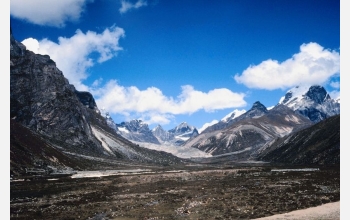News Release 07-033
New Modeling Study Forecasts Disappearance of Existing Climate Zones
Tropics and subtropics may develop new climates

Climate change is affecting ecosystems from the tropics to high mountains like the Himalayas.
March 27, 2007
This material is available primarily for archival purposes. Telephone numbers or other contact information may be out of date; please see current contact information at media contacts.
A new climate modeling study forecasts the complete disappearance of several existing climates in tropical highlands and regions near the poles, while large swaths of the tropics and subtropics may develop new climates unlike any seen today.
In general, the models show that existing climate zones will shift toward higher latitudes and higher elevations, squeezing out the climates at the extremes--tropical mountaintops and the poles--and leaving room for unfamiliar climes and new ecological niches around the equator.
The work, by researchers at the University of Wisconsin-Madison and the University of Wyoming, appears online in the journal Proceedings of the National Academy of Sciences (PNAS) during the week of March 26. The National Science Foundation (NSF) funded the research.
The most severely affected parts of the world span both heavily populated regions, including the southeastern United States, southeastern Asia, and parts of Africa, and known hotspots of biodiversity, such as the Amazonian rainforest and African and South American mountain ranges.
The patterns of change foreshadow significant impacts on ecosystems and conservation. "There is a close correspondence between disappearing climates and areas of biodiversity," says University of Wisconsin at Madison geographer Jack Williams, primary author of the paper, which could increase risk of extinction in the affected areas.
For example, the Andes, Central America, South Africa and the Indonesian Archipelago are all hotspots of biological diversity. The projected disappearance of the climates unique to these regions places some species at risk of extinction.
"As this research shows, studies integrating paleoclimate data, mathematical modeling and ecological principles provide insights into climate cause-and-effect that are of great practical consequence," says David Verardo, program director for paleoclimate at NSF,
Williams and his colleagues foresee the appearance of novel climate zones on up to 39 percent of the world's land surface area by 2100, if current rates of carbon dioxide and other greenhouse gas emissions continue, and the global disappearance of up to 48 percent of current land climates.
The underlying effect is clear, Williams says. "More carbon dioxide in the air means more risk of entirely new climates or climates disappearing."
In an effort to keep up with climate change, plant and animal species already have begun to move away from the equator and toward the colder climates of the poles. In mountain ecosystems, many lower-mountain species are moving higher--to cooler spots. What will happen when they "run out of room" on a mountainside?
The question becomes not just whether a given climate will still exist, but "will a species be able to keep up with its climatic zone?" Williams says.
The work was conducted in collaboration with Stephen Jackson at the University of Wyoming and John Kutzbach at the University of Wisconsin.
-NSF-
Media Contacts
Cheryl Dybas, NSF, (703) 292-7734, email: cdybas@nsf.gov
Jill Sakai, University of Wisconsin at Madison, (608) 262-7734, email: jasakai@wisc.edu
The U.S. National Science Foundation propels the nation forward by advancing fundamental research in all fields of science and engineering. NSF supports research and people by providing facilities, instruments and funding to support their ingenuity and sustain the U.S. as a global leader in research and innovation. With a fiscal year 2023 budget of $9.5 billion, NSF funds reach all 50 states through grants to nearly 2,000 colleges, universities and institutions. Each year, NSF receives more than 40,000 competitive proposals and makes about 11,000 new awards. Those awards include support for cooperative research with industry, Arctic and Antarctic research and operations, and U.S. participation in international scientific efforts.
Connect with us online
NSF website: nsf.gov
NSF News: nsf.gov/news
For News Media: nsf.gov/news/newsroom
Statistics: nsf.gov/statistics/
Awards database: nsf.gov/awardsearch/
Follow us on social
Twitter: twitter.com/NSF
Facebook: facebook.com/US.NSF
Instagram: instagram.com/nsfgov


